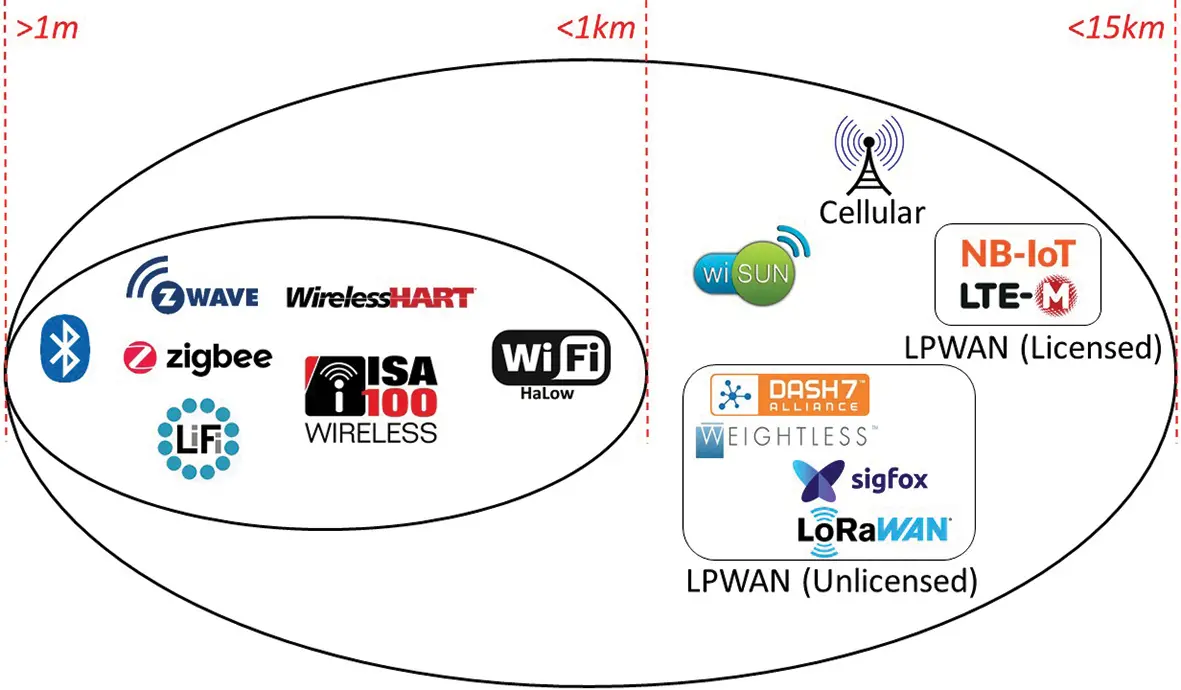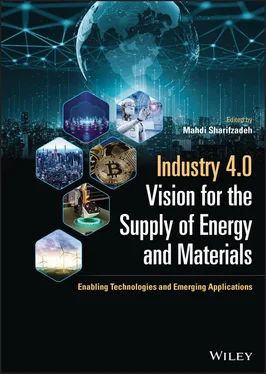Industry 4.0 Vision for the Supply of Energy and Materials
Здесь есть возможность читать онлайн «Industry 4.0 Vision for the Supply of Energy and Materials» — ознакомительный отрывок электронной книги совершенно бесплатно, а после прочтения отрывка купить полную версию. В некоторых случаях можно слушать аудио, скачать через торрент в формате fb2 и присутствует краткое содержание. Жанр: unrecognised, на английском языке. Описание произведения, (предисловие) а так же отзывы посетителей доступны на портале библиотеки ЛибКат.
- Название:Industry 4.0 Vision for the Supply of Energy and Materials
- Автор:
- Жанр:
- Год:неизвестен
- ISBN:нет данных
- Рейтинг книги:4 / 5. Голосов: 1
-
Избранное:Добавить в избранное
- Отзывы:
-
Ваша оценка:
- 80
- 1
- 2
- 3
- 4
- 5
Industry 4.0 Vision for the Supply of Energy and Materials: краткое содержание, описание и аннотация
Предлагаем к чтению аннотацию, описание, краткое содержание или предисловие (зависит от того, что написал сам автор книги «Industry 4.0 Vision for the Supply of Energy and Materials»). Если вы не нашли необходимую информацию о книге — напишите в комментариях, мы постараемся отыскать её.
Explore the impact of Industry 4.0 technologies on the supply chain with this authoritative text written by a leader in his field Industry 4.0 Vision for the Supply of Energy and Materials,
Industry 4.0 Vision for the Supply of Energy and Materials
Industry 4.0 Vision for the Supply of Energy and Materials — читать онлайн ознакомительный отрывок
Ниже представлен текст книги, разбитый по страницам. Система сохранения места последней прочитанной страницы, позволяет с удобством читать онлайн бесплатно книгу «Industry 4.0 Vision for the Supply of Energy and Materials», без необходимости каждый раз заново искать на чём Вы остановились. Поставьте закладку, и сможете в любой момент перейти на страницу, на которой закончили чтение.
Интервал:
Закладка:
1.3.4 Power Efficiency
Power efficiency is a qualitative metric that represents energy consumption of system components. In wireless networks, energy consumption depends on data rate, network topology, MAC protocol, and hardware design [49]. One possible solution to optimize system power consumption is using dynamic power management to boost system efficiency. Power efficiency and reliability are also closely interconnected. In fact, while better power efficiency will lead to higher reliability, system demands on ultra-reliable low latency communication may cause significant energy consumption [52]. It is thus necessary to consider well-thought trade-offs under the acceptable level of system complexity.
1.3.5 Simplicity
Although adopting Industry 4.0 unveils great potentials in industrial landscape, interconnected supply chain will be highly affected by additional complexity in mobility, sensory systems, machines, and information [53]. Recently, a number of technologies have been standardized, and many proprietary alternatives are constantly being offered for wireless communication [54]. Wireless solutions and their heterogeneous connectivity foreseen in the context of Industry 4.0 result in increased amount of generated data, parameters, and variables in networks. Integrating novel automation systems and advanced monitoring techniques increases the overall degree of complexity in products, enterprises, and the underlying network infrastructure. For example, an industrial site is now remotely accessible through the Internet, and its generated information should be integrated for adaptive and effective decision-making. Decentralized decision-making is one possible solution to reduce complexity. Such approach is based on independent decision-making at lower layers and provides more flexibility for customized products and flexible environments. In conflicts between decision-makers at such levels, decision-making tasks are delegated and handled to other levels.
1.3.6 Scalability
Wireless networks in industrial environments often rely on solid infrastructures in which large number of devices are randomly spread over a wide deployment area. In addition, communication networks and protocols should be dynamic and support different types of network changes such as device replacement, service modifications, and system upgrades without degrading the desired efficiency and operation. To establish connections and maintain autonomous network connectivity in such environments, wireless systems should be scalable and comply with real-time changes. Scalability is primarily determined by MAC design, and developing scalable MAC protocols is highly challenging [49]. Various techniques are employed in MAC layer that utilize diversity in frequency band, time, and space to deal with scalability. For instance, contention-free conventions such as time-division multiple access (TDMA) protocols are considered to impose strict constraint on network density and fulfill desired quality of service (QoS).
1.3.7 Security
Industrial systems are often equipped with both advanced and aging machines. The equipment might be located in remote areas, and it is often hard to be replaced or moved. In such systems, connectivity of old machines is not fully supported by the modern and state-of-the-art device monitoring capabilities. Therefore, interconnecting and integrating equipment can provide a target entry point for cyberattacks. Security should also be considered as an essential feature in high-level design of industrial wireless networks to ensure secure data aggregation and authentication. Therefore, security overheads should always be considered delicately in connection with other design criteria, and a proper balance should be pursued with respect to other QoS performance requirements in heterogeneous industrial networks.
1.4 Wireless Technology and International Standards
Industrial use of wireless communication is evolving and requires development of innovative technologies that enable industrial services. Different wireless technologies and standards across multiple industries are often adapted (modified or even redesigned) by an industry to fulfill its diverse requirements in terms of respective key performance metrics. Consequently, the standardization efforts aim at addressing such requirements according to the levels of QoS and working channels [55, 56]. Although wireless networks offer diverse and dynamic approaches for connectivity, it should be noted that none of these technologies have become prominent in the market. This is mainly due to the limitations of such technologies and lack of reliable business models [57].
Wireless communication technologies in industrial IoT span over a wide range of carrier frequencies and could support connectivity in the order of microsecond latency. For instance, the latency of Wireless Industrial Automation and Process Automation (WIA-PA) network is at least 10 ms with the range of up to 100 m [58]. Even though the communication link of this technology is reliable and fast, its range is limited. The existing trade-offs in wireless technologies are not just between latency and range, and other parameters such as channel bandwidth, data rate, number of nodes per network, and energy consumption are not the same across different wireless technologies. This wide variety of options for broad and diversified use cases makes selection of potential technologies even more challenging. As shown in Figure 1.3, industrial wireless technologies can be categorized into short-range and long-range technologies. Many technologies have arisen in both markets, as shown in Figure 1.3.

Figure 1.3 Wireless Technologies Range Coverage.
1.4.1 Short-Range Wireless Communication
Short-range communication technologies use radio waves to transmit data to a receiving node within a very short distance. Their offered range is generally suited for wireless personal area network (WPAN) and wireless local area network (WLAN). The distinct feature of short-range wireless communication is the low power required to communicate, making them suitable for battery-equipped mobile devices. A number of such protocols discussed here are Zigbee, WirelessHART, ISAl00.11a, Bluetooth and WIA-PA, and all are governed by IEEE 802.15 standards. In addition, we review Wi-Fi networks regulated by the IEEE 802.11 standard.
1.4.1.1 IEEE 802.15.4 Standard
The IEEE 802.15.4 standard was initially developed for WPAN and utilizes transceivers with low power consumption to offer low to moderate data rates ( Kbps to several Mbps ) . Over time, it has undergone a number of improvements to address the requirements of various use cases [59]. Many industrial IoT applications employ this standard for slow-paced continuous processes (up to 250 Kbps ) and long durability transmissions to carry process automation data.
For transmission of mission-critical data, this standard defines a physical layer (PHY) and a medium access control (MAC) sublayer for low rate WPAN. Two node classes are introduced to operate on the MAC layer: (1) full function device (FFD); and (2) reduced function device (RFD). The FFD node is more effective and implements full protocol in the network. It can play three roles in the network, namely, the personal area network (PAN), coordinator, coordinator of the network, or act as a device (functional mode). On the other hand, the RFD node has more limited resources and performs extremely simple tasks such as sensing the environment. In this standard, the power consumption of bit transmission is governed by its deployed hardware [57]. Since forwarding nodes (e.g., routers) should be always available and set to “on,” irrespective of their actual load of traffic, energy consumption of IEEE 802.15.4 is high [60]. In addition, the single channel property of the IEEE 802.15.4 MAC layer is not reliable and suffers from a high level of signal fading and destructive interference, particularly in multi-hop scenarios.
Читать дальшеИнтервал:
Закладка:
Похожие книги на «Industry 4.0 Vision for the Supply of Energy and Materials»
Представляем Вашему вниманию похожие книги на «Industry 4.0 Vision for the Supply of Energy and Materials» списком для выбора. Мы отобрали схожую по названию и смыслу литературу в надежде предоставить читателям больше вариантов отыскать новые, интересные, ещё непрочитанные произведения.
Обсуждение, отзывы о книге «Industry 4.0 Vision for the Supply of Energy and Materials» и просто собственные мнения читателей. Оставьте ваши комментарии, напишите, что Вы думаете о произведении, его смысле или главных героях. Укажите что конкретно понравилось, а что нет, и почему Вы так считаете.












